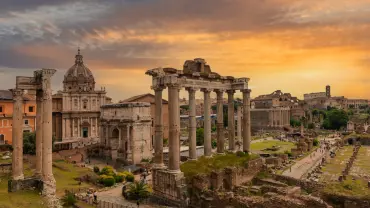Of the famed Seven Wonders of the Ancient World, the Hanging Gardens of Babylon is yet one whose very existence remains in dispute. Envisioned as magnificently elaborate terraces of lush trees, shrubs and vines, held aloft by architecture of staggering greatness, Babylon’s hanging gardens remain elusive, a point of contention for archaeologists, academics, historians and scholars for centuries.
No extant Babylonian writings currently exist that reference Babylon’s hanging gardens, and no conclusive archaeological proof of their existence has ever been uncovered at the ruins of the ancient city, located near the modern-day Iraqi city of Hillah, around 100 kilometres south of Baghdad.
Did the Hanging Gardens of Babylon exist at all? Were they a collective figment of the imagination of the ancients? Were they built, but not in Babylon? Will we ever see real images of Babylon’s hanging gardens? Let’s dive into the verdant greenery of ancient history as we attempt to shed light on one of the world’s most perplexing conundrums.
The Story of the Hanging Gardens of Babylon
Perhaps the most popular version of the story is that the hanging gardens were built around 600 BC by Neo-Babylonian King Nebuchadnezzar II for his wife Amytis. It’s said they were created because she missed the rolling green countryside of her Median homeland, today located between western and northern Iran.
The gardens have also been attributed to Semiramis, the semi-divine Lydian-Babylonian queen. In fact the gardens are sometimes referred to as the Hanging Gardens of Semiramis.
The Hanging Garden Facts
When it comes to facts about the Hanging Gardens, they are few and far between at best. Greek and Roman texts paint a vivid tableau of this lofty paradise. Greek writers such as Strabo and Diodorus Siculus, and Roman historian Quintus Curtius Rufus, variously mention gardens that seemingly defied gravity, with flora cascading from huge vaulted terraces, nourished by an ingenious irrigation system known today as an Archimedes screw. But, crucially, these accounts of the Hanging Gardens of Babylon were often second or third hand, written by chroniclers who had never personally witnessed the marvels they described. This reliance on hearsay makes it challenging to separate fact from fiction.
The first recorded mention of Babylon’s hanging gardens comes from a Babylonian priest named Berossus, who wrote his account around 290 BC. Indeed he chronicled the rule of Nebuchadnezzar II and stands as the sole source attributing the construction of the hanging gardens to that king.
However it’s worth noting that the original accounts of Berossus haven’t survived. His quote comes via Flavius Josephus, a Roman historian writing some two centuries after Berossus’ account.
The translation is as follows – In this palace he erected very high walls, supported by stone pillars; and by planting what was called a pensile paradise, and replenishing it with all sorts of trees, he rendered the prospect an exact resemblance of a mountainous country. This he did to gratify his queen, because she had been brought up in Media, and was fond of a mountainous situation.
Were the Hanging Gardens of Babylon in Babylon?

A suggested location of the Hanging Gardens of Babylon (Credit: Heritage Images / Contributor via Getty Images)
As we’ve mentioned, whether they existed at all is a subject of scholarly debate, but one school of thought suggests the reason why no evidence of the gardens of Babylon have been discovered within the ruins of Babylon is that they were never built there.
Instead, they may have been built over three hundred miles to the north, in the ancient city of Nineveh, on the outskirts of the modern-day Iraqi city of Mosul. In the nineteenth century, British archaeologist Sir Austen Henry Layard unearthed massive stone panels depicting lush gardens, raised on terraces, and fed by aqueducts. Could this be the true location of the Hanging Gardens of Babylon?
Further research, largely championed and undertaken by Dr Stephanie Dalley of Oxford University, points to another compelling clue, a cuneiform prism of the Assyrian King Sennacherib, where the king describes a garden he constructed. It states, ‘I raised the height of the surroundings of the palace, to be a Wonder for all Peoples.’ His garden was said to be a technological marvel, employing an Archimedes screw to bring water from the Tigris River to the terraced gardens. This mechanism aligns with accounts of the innovative irrigation system believed to have sustained the hanging gardens.

Read More About: Engineering
The Largest Botanical Garden in the World
Recent excavations have revealed the presence of an extensive aqueduct system carved with words translated as ‘Sennacherib king of the world king of Assyria. Over a great distance I had a watercourse directed to the environs of Nineveh’, and a bas-relief depicts what is thought to be an elaborate tiered garden.
While these pieces of evidence are tantalising, definitive proof connecting Nineveh to the gardens of Babylon remains elusive. What’s clear however, is that whether in Babylon or Nineveh, the gardens – if they were ever built and not a poetic creation – represent an unparalleled feat of ancient engineering and imagination.
A 2,500 Year-Old Mystery Hangs in the Balance
The quest to unveil the truth of the Hanging Gardens of Babylon is emblematic of the thirst for knowledge about the ancient world. Will there ever be remains discovered providing real images of Babylon’s hanging gardens? Or even Nineveh’s hanging gardens for that matter?
Must Read
As with many ancient enigmas, the sands of time may have become too obscure to discern fact from fiction conclusively, and Babylon’s hanging gardens remain a historical mystery to be solved.












